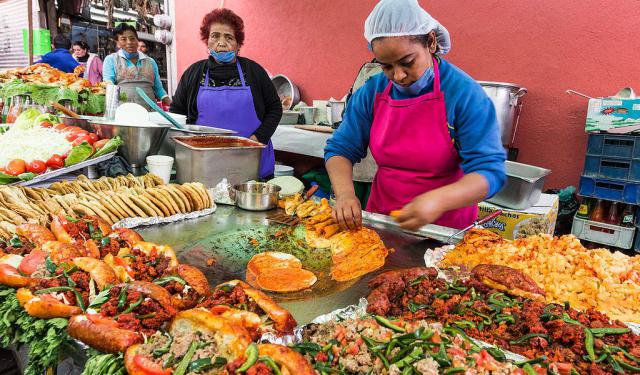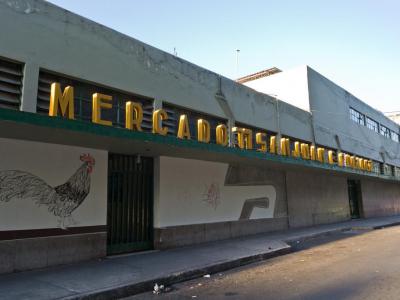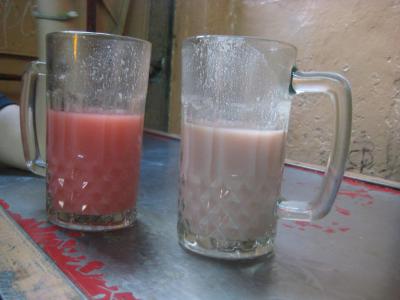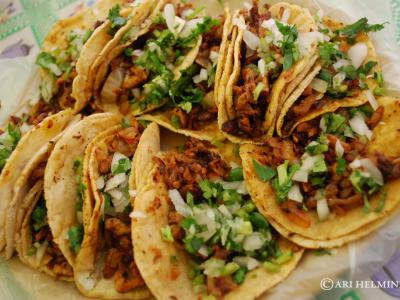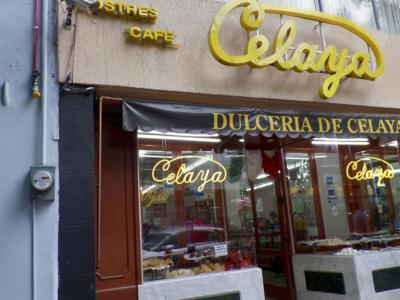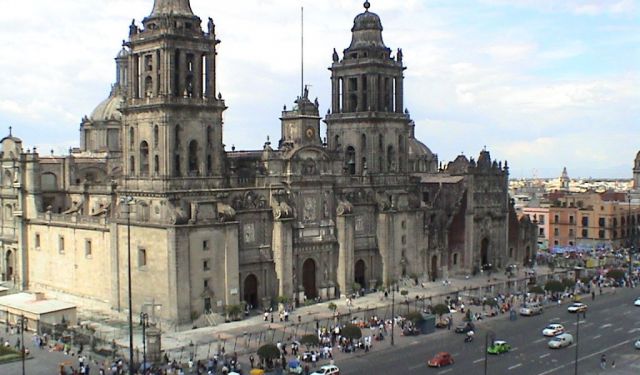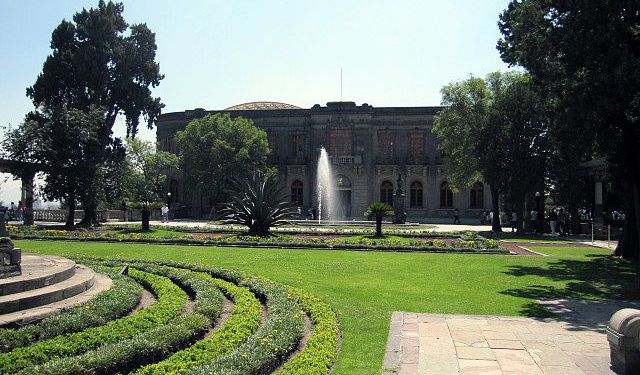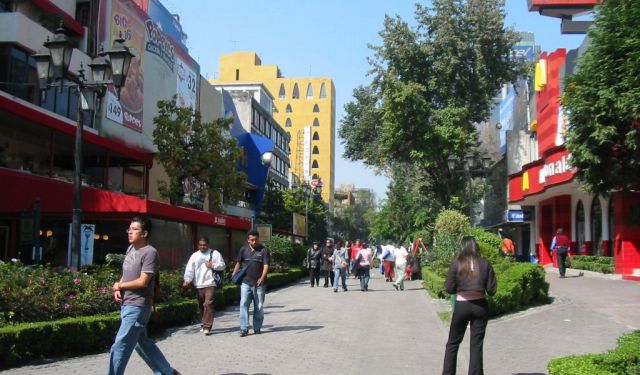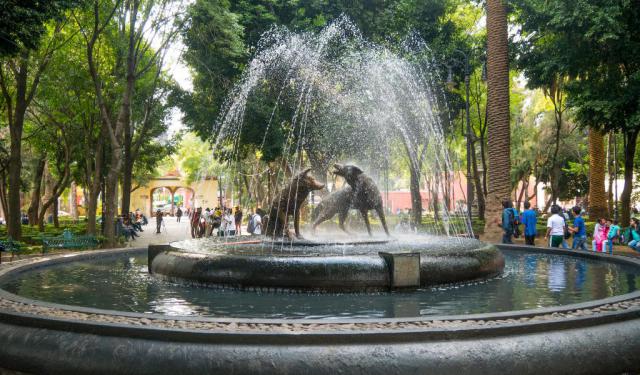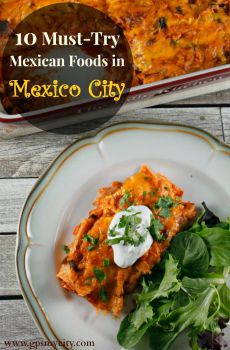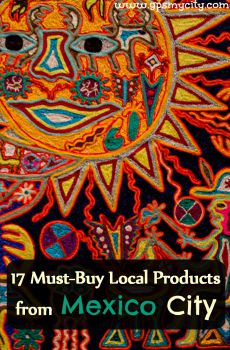Historic Center Food Tour (Self Guided), Mexico City
A combination of history and tradition in Mexico City permeates all aspects of life, including food. For centuries, food and drink have been an inseparable part of the city's culture. Within Mexico City's bustling historic center, you can find a variety of culinary gems that offer a taste of what we call diverse Mexican cuisine.
One of the must-visit spots here is the San Juan Market. This market is a food lover's paradise, offering a wide range of fresh ingredients, including exotic meats, seafood, and spices. You can explore the market and even sample some delicious street food, such as tacos and tamales, prepared right in front of you.
For those looking to experience a traditional Mexican drink, Pulqueria Las Duelistas is a great choice. Pulque, a fermented agave drink, has been enjoyed for centuries in Mexico. Las Duelistas serves a variety of pulque flavors in a cozy and authentic setting, allowing you to savor this unique beverage.
If you're in the mood for some mouthwatering tacos, El Huequito is the place to go. This iconic taqueria has been serving up some of the best Al Pastor tacos in the city for decades. The tender, marinated pork is sliced right from the vertical rotisserie (trompo) and served in warm tortillas with fresh toppings and salsas.
To satisfy your sweet tooth, make sure to visit Dulceria de Celaya. This historic candy shop has made traditional Mexican candies and sweets since the 19th century. Here, you can find an array of sugary delights, including candied fruits, chocolates, and marzipan.
It doesn't take long to realize that Mexico City's historic center offers a culinary adventure like no other. The area's vibrant food scene is sure to leave your taste buds delighted and your stomach satisfied. So, take a journey through the flavors of Mexico City now and enjoy the unforgettable gastronomic experience!
One of the must-visit spots here is the San Juan Market. This market is a food lover's paradise, offering a wide range of fresh ingredients, including exotic meats, seafood, and spices. You can explore the market and even sample some delicious street food, such as tacos and tamales, prepared right in front of you.
For those looking to experience a traditional Mexican drink, Pulqueria Las Duelistas is a great choice. Pulque, a fermented agave drink, has been enjoyed for centuries in Mexico. Las Duelistas serves a variety of pulque flavors in a cozy and authentic setting, allowing you to savor this unique beverage.
If you're in the mood for some mouthwatering tacos, El Huequito is the place to go. This iconic taqueria has been serving up some of the best Al Pastor tacos in the city for decades. The tender, marinated pork is sliced right from the vertical rotisserie (trompo) and served in warm tortillas with fresh toppings and salsas.
To satisfy your sweet tooth, make sure to visit Dulceria de Celaya. This historic candy shop has made traditional Mexican candies and sweets since the 19th century. Here, you can find an array of sugary delights, including candied fruits, chocolates, and marzipan.
It doesn't take long to realize that Mexico City's historic center offers a culinary adventure like no other. The area's vibrant food scene is sure to leave your taste buds delighted and your stomach satisfied. So, take a journey through the flavors of Mexico City now and enjoy the unforgettable gastronomic experience!
How it works: Download the app "GPSmyCity: Walks in 1K+ Cities" from Apple App Store or Google Play Store to your mobile phone or tablet. The app turns your mobile device into a personal tour guide and its built-in GPS navigation functions guide you from one tour stop to next. The app works offline, so no data plan is needed when traveling abroad.
Historic Center Food Tour Map
Guide Name: Historic Center Food Tour
Guide Location: Mexico » Mexico City (See other walking tours in Mexico City)
Guide Type: Self-guided Walking Tour (Sightseeing)
# of Attractions: 4
Tour Duration: 1 Hour(s)
Travel Distance: 1.6 Km or 1 Miles
Author: doris
Sight(s) Featured in This Guide:
Guide Location: Mexico » Mexico City (See other walking tours in Mexico City)
Guide Type: Self-guided Walking Tour (Sightseeing)
# of Attractions: 4
Tour Duration: 1 Hour(s)
Travel Distance: 1.6 Km or 1 Miles
Author: doris
Sight(s) Featured in This Guide:
- San Juan Market
- Pulqueria Las Duelistas
- El Huequito
- Dulceria de Celaya
1) San Juan Market
Built in 1955, San Juan Market is one of Mexico City's oldest marketplaces. Originally established to regulate sales by small-scale vendors, it is located in the heart of the historic center near San Juan Plaza. Its origins in offering fine foods date back to the early 20th century when it was situated on the grounds of the former Buen Tono cigar company's warehouses, officially dedicated by its previous owner, Ernesto Pugibet.
The San Juan Market is distinct from others due to its unique specialization and clientele. Originally centered on basic foodstuffs, it evolved in the 1970s to serve chefs, gastronomy students, restaurateurs, and food enthusiasts, many from abroad. They've developed lasting connections with specific vendors offering gourmet and exotic delicacies, some of which are exclusive to this market. Its male-dominated customer base earned it the nickname "men's market."
At this lively market, visitors enjoy a wide range of meats and fish, including local delicacies and rare imports like iguana, skunk, deer, rabbit, crocodile, and more. There are even uncommon items not typically found in Mexican cuisine, such as ostrich, buffalo, lion, and tiger meats, sourced from both local and international suppliers.
The San Juan market offers a wide variety of poultry, seafood (including caviar), and traditional pre-Hispanic insect staples like tarantulas, scorpions, grasshoppers, and more. They can be enjoyed in various dishes, tacos, or as garnishes.
In addition to its impressive meat and seafood sections, the market boasts an abundance of fruits, vegetables, edible flowers, and herbs, many of which are sourced from abroad to cater to diverse international cuisines.
The San Juan Market is distinct from others due to its unique specialization and clientele. Originally centered on basic foodstuffs, it evolved in the 1970s to serve chefs, gastronomy students, restaurateurs, and food enthusiasts, many from abroad. They've developed lasting connections with specific vendors offering gourmet and exotic delicacies, some of which are exclusive to this market. Its male-dominated customer base earned it the nickname "men's market."
At this lively market, visitors enjoy a wide range of meats and fish, including local delicacies and rare imports like iguana, skunk, deer, rabbit, crocodile, and more. There are even uncommon items not typically found in Mexican cuisine, such as ostrich, buffalo, lion, and tiger meats, sourced from both local and international suppliers.
The San Juan market offers a wide variety of poultry, seafood (including caviar), and traditional pre-Hispanic insect staples like tarantulas, scorpions, grasshoppers, and more. They can be enjoyed in various dishes, tacos, or as garnishes.
In addition to its impressive meat and seafood sections, the market boasts an abundance of fruits, vegetables, edible flowers, and herbs, many of which are sourced from abroad to cater to diverse international cuisines.
2) Pulqueria Las Duelistas
Sitting just a few blocks south of the Palacio de Bellas Artes, Pulqueria Las Duelistas is a great place to sample pulque. This freshly fermented sap of giant agave, with a slightly viscous texture and many well-documented nutritional qualities, has about the same potency as beer. The regular crowd of young locals and youngsters at heart creates a bit of a chaotic vibe here, even in the earlier hours, and, as the day progresses, it gets younger with those packing this small bar to the full so as to enjoy a dizzying variety of pulque.
Graffiti-like painted walls and ceilings, metal stools without cushions, ceiling fans and no A/C... this is what makes a pulqueria and is definitely not for the shy! You have to know what you’re getting into before coming here. To an outsider, it may take a bit of courage to enter the saloon style doors, but if you do get in, you'll be happy you did, albeit not without some feeling of an oddity sitting next to a pile of empty plastic bins. With luck you may find yourself a spot at a communal table to squish in between the locals who will be surprised to see extranjeros ordering some ‘pulques de canela.’
Why You Should Visit:
To trace the roots of Mexico City drinking culture. Back in the 1880s, they say, there was a pulqueria on every block in the city. Now there are just a handful of places remaining that exclusively serve fresh pulque. Perfect for a quick break in a day of touring, when you’re not really hungry.
Tip:
While there's a variety of fruit-flavored versions, the original unadulterated Aztec concoction, called Pulque Blanco, which is tart and funky, really does stand out from the crowd. It’s very mild but with its own tang.
Otherwise, order one of the 40+ revolving “curados,” naturally-flavored pulques of which there are always several available. Try the guava, peanut, celery or cinnamon pulque in particular (dusted with fresh cinnamon on top). Very delicious!
There’s a lot of pride around pulque, and a certain communal aspect to it, so don’t be surprised if someone pours you a taste from his or her plastic pitcher.
Graffiti-like painted walls and ceilings, metal stools without cushions, ceiling fans and no A/C... this is what makes a pulqueria and is definitely not for the shy! You have to know what you’re getting into before coming here. To an outsider, it may take a bit of courage to enter the saloon style doors, but if you do get in, you'll be happy you did, albeit not without some feeling of an oddity sitting next to a pile of empty plastic bins. With luck you may find yourself a spot at a communal table to squish in between the locals who will be surprised to see extranjeros ordering some ‘pulques de canela.’
Why You Should Visit:
To trace the roots of Mexico City drinking culture. Back in the 1880s, they say, there was a pulqueria on every block in the city. Now there are just a handful of places remaining that exclusively serve fresh pulque. Perfect for a quick break in a day of touring, when you’re not really hungry.
Tip:
While there's a variety of fruit-flavored versions, the original unadulterated Aztec concoction, called Pulque Blanco, which is tart and funky, really does stand out from the crowd. It’s very mild but with its own tang.
Otherwise, order one of the 40+ revolving “curados,” naturally-flavored pulques of which there are always several available. Try the guava, peanut, celery or cinnamon pulque in particular (dusted with fresh cinnamon on top). Very delicious!
There’s a lot of pride around pulque, and a certain communal aspect to it, so don’t be surprised if someone pours you a taste from his or her plastic pitcher.
3) El Huequito
They say, you shouldn’t leave Mexico City without eating at least three Tacos Al Pastor, which is a Mexican take on Middle Eastern shawarma – only with pork instead of lamb, tortilla instead of pita, and a spicy adobo rub. They also say that they the best tacos you may possibly have ever are the ones by El Huequito. In business since 1959, this place claims to be the first to serve this dish in Mexico City. Although today El Huequito has several sit-down locations dotted around the city, the original “hole in the wall” with a skinny high-topped table out front is still considered to be their best.
Famous among "Tacos Al Pastor" aficionados, this small, closet-sized stall, with no sitting area, has a lot of character and is always surrounded with tons of locals. Prepare to stand by the sidewalk to eat your tacos, which is, in fact, the proper way to have a taco in the first place. Whilst adhering to the adage “do one thing, and do it well,” at El Huequito, alongside traditional Tacos Al Pastor, you can get fresh tortillas, gringas, salads, and guacamole salsas to die for. Paired with their on-point service, this ensures the dining experience by far more more than just casual.
Why You Should Visit:
To try the no-frills grande dame of Tacos Al Pastor the proper way, i.e. shaved off a rotating spit and eaten while standing on the sidewalk.
Tip:
Make sure to add a dollop of herby-spicy green salsa on top of your Tacos Al Pastor, and grab plenty of napkins.
Famous among "Tacos Al Pastor" aficionados, this small, closet-sized stall, with no sitting area, has a lot of character and is always surrounded with tons of locals. Prepare to stand by the sidewalk to eat your tacos, which is, in fact, the proper way to have a taco in the first place. Whilst adhering to the adage “do one thing, and do it well,” at El Huequito, alongside traditional Tacos Al Pastor, you can get fresh tortillas, gringas, salads, and guacamole salsas to die for. Paired with their on-point service, this ensures the dining experience by far more more than just casual.
Why You Should Visit:
To try the no-frills grande dame of Tacos Al Pastor the proper way, i.e. shaved off a rotating spit and eaten while standing on the sidewalk.
Tip:
Make sure to add a dollop of herby-spicy green salsa on top of your Tacos Al Pastor, and grab plenty of napkins.
4) Dulceria de Celaya
Established in 1874 in the city center of Mexico City, this sweet boutique is dedicated to the promotion of traditional Mexican confections with a decidedly antique feel. The patina acquired by the shop over the years attests to its long history. La Dulcería de Celaya was founded by the Guizar family with the idea of selling candy from all over Mexico under one roof. Over time, they started producing their own candy in the store basement.
Today, every single candy, cookie or cake displayed in the shop is made at the company’s own factory. The production has long outgrown the basement workshop, but the sweets are still made in the same artisanal way, following the recipes used for more than a century. The production range includes traditional Mexican biscuits and sweets, among which are coconut stuffed limes (limones cocadas), pig-shaped cookies, Tortitas de Puebla (pie crust type exterior with caramel filling), colorful lagrimas (flavored liquid filled candies) and many other items. The sweets are organized neatly in trays, like precious jewels of every imaginable color, so it's fun to merely browse.
With a green and gold Art Nouveau sign, complex tile work and ornate walls, this shop projects the image of a Parisian patisserie, but the meringues, candied fruit, and coconut-flavored sweets bring you back to Mexico City. Anyone with a sweet tooth will certainly find something to their liking here. These sweets are also great gifts to take home.
Tip:
If money is no object, stock up on traditional Mexican sweets. Here are some suggestions: aleluyas – small, round candies made from either pecans, dates, pine nuts, almonds or milk; mazapanes – made with peanut paste; alegrías – bars made from amaranth seeds held together with honey; cocadas – made with coconut flakes; bollitos – rolls of candied fruit such as guava or strawberry; camotes – traditional sweet potato candy from the state of Puebla; cajeta – candies made with caramelized goat’s milk from Celaya in the state of Guanajuato; tamarind candy – available in two versions, sweet and spicy; enjambres – balls of chocolate and pecans, covering marshmallows and in tarts, cakes and cookies; and tres leches cakes.
And if you're on a strict budget, consider a piece of crystallized fruit like lime or pineapple, or a shatteringly crisp meringue.
Today, every single candy, cookie or cake displayed in the shop is made at the company’s own factory. The production has long outgrown the basement workshop, but the sweets are still made in the same artisanal way, following the recipes used for more than a century. The production range includes traditional Mexican biscuits and sweets, among which are coconut stuffed limes (limones cocadas), pig-shaped cookies, Tortitas de Puebla (pie crust type exterior with caramel filling), colorful lagrimas (flavored liquid filled candies) and many other items. The sweets are organized neatly in trays, like precious jewels of every imaginable color, so it's fun to merely browse.
With a green and gold Art Nouveau sign, complex tile work and ornate walls, this shop projects the image of a Parisian patisserie, but the meringues, candied fruit, and coconut-flavored sweets bring you back to Mexico City. Anyone with a sweet tooth will certainly find something to their liking here. These sweets are also great gifts to take home.
Tip:
If money is no object, stock up on traditional Mexican sweets. Here are some suggestions: aleluyas – small, round candies made from either pecans, dates, pine nuts, almonds or milk; mazapanes – made with peanut paste; alegrías – bars made from amaranth seeds held together with honey; cocadas – made with coconut flakes; bollitos – rolls of candied fruit such as guava or strawberry; camotes – traditional sweet potato candy from the state of Puebla; cajeta – candies made with caramelized goat’s milk from Celaya in the state of Guanajuato; tamarind candy – available in two versions, sweet and spicy; enjambres – balls of chocolate and pecans, covering marshmallows and in tarts, cakes and cookies; and tres leches cakes.
And if you're on a strict budget, consider a piece of crystallized fruit like lime or pineapple, or a shatteringly crisp meringue.
Walking Tours in Mexico City, Mexico
Create Your Own Walk in Mexico City
Creating your own self-guided walk in Mexico City is easy and fun. Choose the city attractions that you want to see and a walk route map will be created just for you. You can even set your hotel as the start point of the walk.
Historic Center Walking Tour
Mexico City is the oldest capital in the Americas and is one of the two founded by indigenous people. Originally known as Mexico Tenochtitlan, the city was built by the Mexicas (aka Aztecs) in 1325. According to a legend, the Mexicas' principal god, Huitzilopochtli, pointed out the site of the future settlement with an image of a golden eagle perched on a prickly pear cactus, devouring a... view more
Tour Duration: 2 Hour(s)
Travel Distance: 2.7 Km or 1.7 Miles
Tour Duration: 2 Hour(s)
Travel Distance: 2.7 Km or 1.7 Miles
Chapultepec Park Walking Tour
Nicknamed "the Lungs of Mexico City", Chapultepec Park is a vast oasis of lush greenery in the heart of the Mexican capital, sprawling over 686 hectares of land, providing a vital source of oxygen for the city. Rich in natural beauty, historical landmarks, and vibrant atmosphere, throughout centuries, this park has inspired various works of literature, poetry, and visual art, further... view more
Tour Duration: 2 Hour(s)
Travel Distance: 3.8 Km or 2.4 Miles
Tour Duration: 2 Hour(s)
Travel Distance: 3.8 Km or 2.4 Miles
Zona Rosa Walking Tour
Zona Rosa, or "Pink Zone" in English, is a vibrant neighborhood near the historic center of the Mexican capital which is known for its lively atmosphere and diverse cultural scene. The neighborhood's name comes from the pink-colored tiles abundantly used to pave the local streets.
The area rose to prominence in the early 20th century as a residential district for the wealthy... view more
Tour Duration: 2 Hour(s)
Travel Distance: 3.7 Km or 2.3 Miles
The area rose to prominence in the early 20th century as a residential district for the wealthy... view more
Tour Duration: 2 Hour(s)
Travel Distance: 3.7 Km or 2.3 Miles
Coyoacan District Walking Tour
Translated from the Nahuatle language as “The Land of Coyotes”, Coyoacán is a relatively quiet neighborhood in the southern part of Mexico City. Formerly a rural village, over the years Coyoacán has become a rich pocket of art and history in the capital, closely associated with some iconic figures of the 20th century and the tumultuous times in which they lived.
One of its most famous... view more
Tour Duration: 1 Hour(s)
Travel Distance: 2.6 Km or 1.6 Miles
One of its most famous... view more
Tour Duration: 1 Hour(s)
Travel Distance: 2.6 Km or 1.6 Miles
Useful Travel Guides for Planning Your Trip
10 Must-Try Mexican Foods in Mexico City
While Mexico is a treasure trove in terms of cultural and artistic heritage (ancient history, architecture, etc.), the vast majority of visitors to the country are lured mainly by, let's face it, bodily pleasures. The latter are manifested in the form of sandy beaches, sun and, most...
Souvenir Shopping Guide: 17 Must-Buy Local Products from Mexico City
Both historic and modern day Mexico's are worth each other in terms of cultural and artistic heritage. The country's capital Mexico City is a showroom of what the label "Made in Mexico" stands for in its entirety. Whether it's authentic food, drink or piece of craftsmanship...
The Most Popular Cities
/ view all
